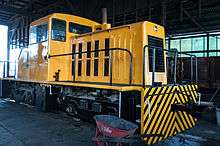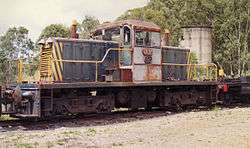BHP Newcastle 37 class
|
42 at the Richmond Vale Railway Museum in 1990 | |||||||||||||||||||||||||||||||||||||||||||||||
| |||||||||||||||||||||||||||||||||||||||||||||||
| |||||||||||||||||||||||||||||||||||||||||||||||
| |||||||||||||||||||||||||||||||||||||||||||||||
| |||||||||||||||||||||||||||||||||||||||||||||||
The BHP Newcastle 37 class were a class of diesel locomotives built by A Goninan & Co, Broadmeadow for the BHP, Newcastle steelworks between 1960 and 1983.
History

In 1960 the first five locomotives numbered 37 to 41 were delivered by A Goninan & Co to a design suitable for use on both the narrow gauge 3 ft (914 mm) ingot system and the 4 ft 8 1⁄2 in (1,435 mm) standard gauge system. These locos were an Australian version of the standard General Electric 80 Ton switcher. Originally two of these five locomotives were fitted with narrow gauge bogies, the other three being fitted with standard gauge bogies. These locos were fitted with 2 Cummins NHS-B1-6 supercharged diesel engines. Whilst the first five were under construction an order for a further six locos to the same specifications was placed, these locos were given numbers 42 to 47.[1]
In 1961 a further 6 locos were ordered from Goninans, these 6 however were powered by two Rolls-Royce C6TFL turbocharged diesel engines. These 6 locos were numbered 48 to 53.[1]
The first 15 locos were swapped between the narrow and standard gauge networks by changing the bogies and couplers. However, by the mid 1960s problems were experienced in working wide standard gauge rolling stock such as the Treadwell hot metal cars. To overcome this it was decided to dedicate 37 to 41 to the narrow gauge network, with 42 to 53 were progressively fitted with 9 ft 9 in (2.97 m) wide cabs and platforms to overcome the visibility problems.[1]
In 1966 a further loco was delivered from Goninans. Numbered 54, it was built with a wide body and fitted with 2 Cummins NHS-B1-6 supercharged engines. The next 2 locos were delivered in 1977 (55 and 56) and were fitted with Cummins NT855 turbocharged engines, the latter built to narrow gauge specifications. Both did not enter service when delivered and were placed in storage, 55 being placed in service in late 1979 and 56 in early 1980. The last 2 (57 and 58) were delivered in 1982, they were fitted with Cummins NT855 turbocharged engines.[1]
In the 1980s the Rolls Royce powered locos and the older Cummins supercharged locos were placed into storage due to difficulties in obtaining spare parts. Later many of these were repowered with Cummins NT855 turbocharged engines, those locos which weren't re-engined were either scrapped or sold.
The introduction of a continuous bloom caster at the steelworks in 1987 saw the phasing out of the narrow gauge rail system with the system being closed in 1991 and the narrow gauge rolling stock and locos scrapped.
With the closure of steel making at Newcastle Steelworks on 30 September 1999 and with the remaining rail traffic being hauled by National Rail, the last 9 locos in service were placed into store and put up for sale.[2] A number were sold to private buyers for use as shunters. Two were sold to the Manildra Group, two to Junee Railway Workshop, two to Loongana Lime and one to Heggies Bulk Haul, Port Kembla, the latter being resold to the Manildra Group. Two been preserved by the Dorrigo Steam Railway & Museum and four by the Richmond Vale Railway Museum.[3]
Class list
| Locomotive | Builder's No. | Entered service | As Built Engine | Body Widened | Withdrawn | Notes |
|---|---|---|---|---|---|---|
| 37 | 2121-001 | 13 Jul 1960 | Cummins NHS 6 | Not widened | 16 Jun 1987 | Scrapped |
| 38 | 2121-001 | 18 Jul 1960 | Cummins NHS 6 | Not widened | 30 Apr 1991 | Scrapped |
| 39 | 2121-003 | 20 Jul 1960 | Cummins NHS 6 | Not widened | 30 Apr 1991 | Scrapped |
| 40 | 2121-004 | 15 Aug 1960 | Cummins NHS 6 | Not widened | 1 Nov 1982 | Scrapped |
| 41 | 2121-005 | 18 Aug 1960 | Cummins NHS 6 | Not widened | 30 Apr 1991 | Scrapped |
| 42 | 3456-006 | 24 Oct 1960 | Cummins NHS 6 | Mar 1967 | 2 Oct 1983 | Preserved Richmond Vale Railway Museum |
| 43 | 3456-007 | 24 Oct 1960 | Cummins NHS 6 | Jan 1968 | ? | Preserved Richmond Vale Railway Museum |
| 44 | 3456-008 | 10 Nov 1960 | Cummins NHS 6 | Feb 1968 | 26 May 1983 | Scrapped |
| 45 | 3456-009 | 14 Nov 1960 | Cummins NHS 6 | Jan 1966 | 2 Jan 1982 | Scrapped |
| 46 | 3456-010 | 1 Dec 1960 | Cummins NHS 6 | Apr 1966 | 11 Jan 1982 | Scrapped |
| 47 | 3456-011 | 8 Dec 1960 | Cummins NHS 6 | Oct 1966 | 1 Jul 1991 | Preserved Dorrigo Steam Railway & Museum |
| 48 | 4970-012 | 22 Sep 1961 | Rolls Royce C6TFL | Aug 1966 | 30 Sep 1999 | Sold Manildra Group Dec 2002 as MM04 |
| 49 | 4970-013 | 29 Sep 1961 | Rolls Royce C6TFL | Feb 1966 | 30 Sep 1999 | Sold Loongana Lime Sep 2002 |
| 50 | 4970-014 | 14 Oct 1961 | Rolls Royce C6TFL | Dec 1967 | 30 Sep 1999 | Sold Loongana Lime Feb 2002 |
| 51 | 4970-015 | 3 Nov 1961 | Rolls Royce C6TFL | Oct 1967 | 30 Sep 1999 | Sold Manildra Group Dec 2002 as MM03 |
| 52 | 4970-016 | 14 Dec 1961 | Rolls Royce C6TFL | Sep 1966 | 1 Jan 1988 | Preserved Dorrigo Steam Railway & Museum |
| 53 | 9211-018 | 16 Apr 1964 | Rolls Royce C6TFL | Jun 1967 | 30 Sep 1999 | Preserved Richmond Vale Railway Museum |
| 54 | 3835-020 | 5 Jan 1966 | Cummins NHS 6 | built wide | 30 Sep 1999 | Preserved Richmond Vale Railway Museum |
| 55 | 3275-051 | 8 Sep 1977 | Cummins NT855L4 | built wide | 30 Sep 1999 | Sold Junee Railway Workshop Jul 2002 |
| 56 | 2967-052 | 11 Nov 1977 | Cummins NT855L4 | Narrow body | 1 Jun 1988 | Scrapped |
| 57 | 6606-182-057 | 13 Dec 1982 | Cummins NT855L4 | built wide | 30 Sep 1999 | Sold Junee Railway Workshop Jul 2002 |
| 58 | 6606-182-058 | 13 Apr 1983 | Cummins NT855L4 | built wide | 30 Sep 1999 | Sold Heggies Bulk Haul, Port Kembla 4 Oct 1999, renumbered HBL58, sold to Manildra Group |
Other buyers
The General Electric 80 Ton switcher locomotive design was used by other industrial manufacturing companies around New South Wales including Sulphide Corporation who purchased one in November 1964 for its Cockle Creek Smelter, Southern Portland Cement who purchased two in July 1967 for use at Marulan South and Berrima, and John Lysaghts who purchased one for use at Port Kembla.[1]
References
- Men, Steel and Rails by David Jehan 1999, Published by BHP ISBN 1-876634-09-X
- Australian Diesel Scene 5 2002, Published by Eveleigh Press ISBN 1-876568-23-2
- Specification sheet ex BHP Newcastle Steelworks diesel shop
- Steel and Rails in Newcastle, by Keith McDonald 1981, Published by Light Railway Research Society of Australia ISBN 0-909340-15-3
- Australian Diesel Scene 5, by Leon Oberg, 2002, published by Eveleigh Press ISBN 1-876568-23-2
